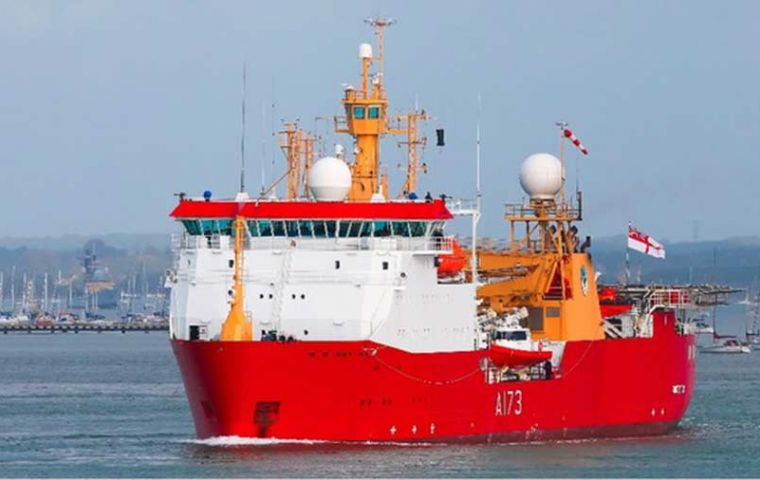MercoPress. South Atlantic News Agency
Ice Patrol HMS Protector sailing to Falklands and Antarctica; she called at St Helena and Rio
 In Rio HMS Protector caught a glimpse of the Brazilian Navy flagship PHM Atlântico, formerly known as HMS Ocean during their quick fuel stop at anchor
In Rio HMS Protector caught a glimpse of the Brazilian Navy flagship PHM Atlântico, formerly known as HMS Ocean during their quick fuel stop at anchor The Royal Navy's ice patrol ship HMS Protector on her trip to the Falkland Islands and Antarctica sailed past an old work colleague during a fuel stop in Rio de Janeiro earlier this week.
Ice patrol ship HMS Protector caught a glimse of the Brazilian Navy flagship PHM Atlântico, formerly known as HMS Ocean during their quick fuel stop at anchor in Brazil.
She was one of the Royal Navy's largest warships before being decommissioned by the Queen in a ceremony in Plymouth. In a tweet, HMS Protector's crew posted their disappointment at the weather but were impressed with the “fabulous location” and seeing ex-HMS Ocean.
The ice patrol ship tweeted: ”A bit too overcast to see Christ The Redeemer, but did catch sight of ex-HMS Ocean (PMH Atlantico)! “Great to stop in such a fabulous location – hopefully next time we'll be able to come ashore!”
In August, Ice patrol ship Protector set sail for Antarctica in a deployment that the ship's company believe could see them make Royal Navy history. The deployment to the Antarctic means HMS Protector will have crossed the Equator and visited both polar circles in a single year.
This will be her first visit to the frozen continent since 2019. The survey/research ship will continue her work supporting scientists from around the world who are studying the impact of global warming.
HMS Protector that underwent a major £14m refit in Middlesbrough last year, is also affectionately referred to as the Royal Navy’s ‘swiss army knife’ – red, versatile, and always there when you need her!
The Ice patrol 'warmed up' for work in sub-zero temperatures by sailing into the Arctic in June to practice crunching ice, venturing further north than any other Royal Navy-s vessel in recent history.
Commanding Officer, Captain Michael Wood, said his ship's return to Antarctica “highlights the Navy and nation's determination to contribute to climate science and limit climate change”. He added: “It's time now for new adventures at the other end of the world.”
On her trip to the South the crew of Protectot called at St Helena in mid Atlantic, where they paid their respects to the thousands of sailors who helped put an end to the slave trade.
They joined leaders of St Helena in a service of remembrance and thanksgiving for the men of the West Africa Squadron – and the tens of thousands of slaves they liberated.
For more than half a century the tiny island – smaller than Edinburgh – was the hub of the fight against the evil trade by the Royal Navy squadron. And for 30 years, the captains and crews of slave ships captured by the Royal Navy were brought to justice in a court established by the Admiralty, while freed slaves were allowed to settle in St Helena – or move on.
Some stayed, but many moved to the West Indies, Cape Town or Sierra Leone – founding the present-day capital Freetown. But thousands of freed slaves never had the chance to enjoy their liberty due to the maltreatment at the hands of their captors; an estimated 8,000 died and most were buried in Rupert’s Valley to the east of Jamestown.
In all, around 150,000 Africans were liberated by the West Africa Squadron – crammed into 1,600 slave ships captured between 1808 and 1860.
The cost to the Royal Navy was also heavy: one sailor died for every nine slaves freed – 17,000 men over the 52-year period – either in action or of disease.




Top Comments
Disclaimer & comment rulesCommenting for this story is now closed.
If you have a Facebook account, become a fan and comment on our Facebook Page!